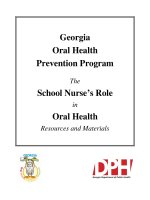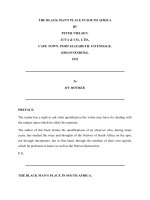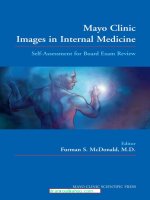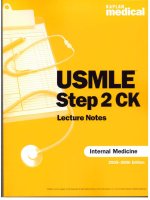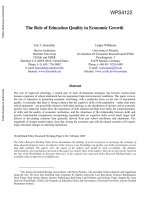The Most Common Inpatient Problems in Internal Medicine pdf
Bạn đang xem bản rút gọn của tài liệu. Xem và tải ngay bản đầy đủ của tài liệu tại đây (2.13 MB, 410 trang )
1600 John F. Kennedy Blvd, Suite 1800
Philadelphia, Pennsylvania 19103–2899
The Most Common Inpatient Problems in Internal Medicine
ISBN-13: 978-1-4160-3203-8
ISBN-10: 1-4160-3203-7
Copyright # 2007, Elsevier Inc. All rights reserved.
No part of this publication may be reproduced or transmitted in any
form or by any means, electronic or mechanical, including photoco-
pying, recording, or any information storage and retrieval system,
without permission in writing from the publisher. Permissions may be
sought directly from Elsevier’s Health Sciences Rights Department in
Philadelphia, PA, USA: phone: (þ1) 215 239 3804, fax: (þ1) 215 239
3805, e-mail: You may also complete
your request on-line via the Elsevier homepage (evier.
com), by selecting ‘Customer Support’ and then ‘Obtaining
Permissions’.
Notice
Knowledge and best practice in this field of Internal Medicine
are constantly changing. As new research and experience
broaden our knowledge, changes in practice, treatment and drug
therapy may become necessary or appropriate. Readers are
advised to check the most current information provided (i) on
procedures featured or (ii) by the manufacturer of each product
to be administered, to verify the recommended dose or formula,
the method and duration of administration, and contraindica-
tions. It is the responsibility of the practitioner, relying on their
own experience and knowledge of the patient, to make diagnoses,
to determine dosages and the best treatment for each individual
patient, and to take all appropriate safety precautions. To the
fullest extent of the law, neither the Publisher nor the Editors
assumes any liability for any injury and/or damage to persons or
property arising out of or related to any use of the material con-
tained in this book.
The Publisher
International Standard Book Number 1-4160-3203-7
Editor: Rolla Couchman
Developmental Editor: Adrianne Brigido
Design Direction: Gene Harris
Printed in the United States of America.
Last digit is the print number: 987654321
Acknowledgments
We learned a tremendous amount about
inpatient medicine during our internship and
residency. We are in debted to the many talented
colleagues, residents, chief residents, fellows,
and staff physicians with whom we worked dur-
ing those formative years. We especially thank
Dr. Joel Katz, the Program Director for the
Internal Medicine training program at Brigham
and Women’s Hospital who constantly strives to
improve the residency program and who has
kindly agreed to write a foreword for this book.
We also thank Dr. Marshall Wolf, a master
clinician-educator, for believing in us and grant-
ing us the privilege of training at one of the best
hospitals in the country. We thank Rolla
Couchman and Dylan Parker, our contacts at
Elsevier, for their expertise, guidance, profes-
sionalism, and patience as we worked toward
meeting deadlines. Without them, this book
would still be a figment of our imagination and
not this work of which we are both very proud.
John Sun would like to thank Dr. David
Katzka and Dr. Anil Rustgi for their outstanding
teaching and mentorship. He also thanks his
parents, his brother, Alan, and his extended
family for their encouragement. Most impor-
tantly, he thanks his wife, Yumee, for her many
years of dedication, love, and support.
Hylton Joffe would like to thank Dr. Samuel
Goldhaber, Dr. Arthur Sasahara, and Dr. Robert
Utiger—phenomenal role models as physicians,
mentors, and human beings. He also thanks his
parents, his sister, Karen, and his brother-in-law,
Daniel, for their encouragement and love. Most
of all, he thanks his wife, Sarah, for her unselfish,
unwavering, and unconditional love and support.
v
Foreword
According to the eminent medical educator,
Dr. Marshall Wolf, the fundamental skill
required to master the Art of Medicine is the
ability to accurately make critical—often
life-sustaining—decisions in the face of
incomplete data. Every trainee and practicing
physician will encounter common medical
conditions with a high degree of regularity,
and needs an approach to clinical decision-
making that is reflexive and yet retains the
nuanced recognition of the subtleties affecting
the individual patient. Skilled providers must
have, at t he same time, a command of
practical, evidence-based management
strategies as well as an appreciation of the
guideposts requiring individual variations. The
latter skill comes only from experience. The
former is the g oal of this clear and
authoritative volume.
Medical textbooks and handbooks play a
vital role in the education of students,
residents, fellows, and practicing physic ians.
This new contri bution, The Most Common
Inpatient Problems in Internal Medicine, is
the result of c ollaboration between two truly
gifted clinicians and teachers, Drs. John Sun
and Hylton Joffe. Without abandoning
subtlety, they have captured the key aspects
of modern therapeutics in chapters addressing
the most frequent and, therefore, most
important acute medic al problems. The text
is organized for clarity, simplicity, and
accessibility—critical comm odities t o the
busy, and often over-stretched, physician-
in-training. I predict with confidence that
this volume w ill play a vital role in teaching
vii
and learning medicine. Future generations of
students and teachers, and ultimately the
patients they serve, will benefit from t his
important contribution.
Joel T. Katz, MD
Director
Internal Medicine Residency Program
Brigham and Women’s Hospital
Member, Academy of Teaching Scholars
Assistant Professor of Medicine
Harvard Medical School
Boston, Massachusetts
viii Foreword
Preface
Are you a medical student, intern, or resident
who is (or will be) caring for patients on the
medical ward? Do you find it challenging to
locate practical and pertinent information about
many of the common inpatient medical condi-
tions? If your answers to these questions are
‘‘yes,’’ then this book is for you!
Not too long ago, we were trying to learn the
basic principles for the day-to-day care of medi-
cal inpatients. We found that review articles and
book chapters provided an overview of medical
topics but often lacked specific information
directly applicable to patient care. Frequently,
we also had difficulty determining the relevance
of findings from original journal articles, espe-
cially when there were prior conflicting studies.
As a result, we learned a vast amount of practical
inpatient medicine from our co-interns,
residents, fellows, and staff physicians. These
teachers explained how to choose a dose
of intravenous furosemide for our patient
with decompensated heart failure or how to
calculate the dose of subcutaneous insulin for a
patient with resolving diabetic ketoacidosis.
Basic concepts such as these have often been
frustratingly difficult to acquire from other
sources. Until now.
Our book, The Most Common Inpatient
Problems in Internal Medicine, provides practical
and pertinent information for the most common
medical problems encountered on the hospital
ward. The chapters cover basic principles that
every house officer should know, emphasizing
‘‘bread-and-butter’’ medicine. You will find use-
ful in formation about common disorders you see
everyday, including heart failure, pancreatitis,
hyperkalemia, acute exacerbation of chronic
obstructive pulmonary disease, asthma, acute
ix
renal failure, hyponatremia, and unstable angina.
After reading this book, you will have a solid
foundation upon which to build your knowledge
as you advance in your career.
You will find answers to the following types
of questions:
What rate and type of intravenous fluid should
I administer to my patient with acute, symp-
tomatic hyponatremia?
Does my patient have iron deficiency anemia
or anemia of chronic disease?
How do I teach my patient with chronic
obstructive pulmonary disease to use a spacer
for delivery of her inhaled glucocorticoids?
How do I differentiate aspiration pneumonia
from chemical pneumonitis and do these
patients require antibiotics?
How can I determine whether my patient’s renal
failure is acute or chronic when prior serum
creatinine measurements are unavailable?
My patient with suspected pulmonary embo-
lism has a normal first-generation lung com-
puted tomography (CT) scan—what should I
do next?
Each chapter is divided into sections that cover
the epidemiology, pathophysiology, signs and
symptoms, laboratory abnormalities, diagnosis, and
management of the disorder under discussion. A
‘‘Key Points’’ box at the beginning of each chapter
highlights some important take-home messages.
Tables and figures clarify important and complex
concepts. Each chapter ends with a list of refer-
ences, which can also be used by those who wish to
further their knowledge in specific areas.
We hope that you will enjoy reading this
book as much as we enjoyed writing it.
Best of luck in your career!
John C. Sun, MD
San Francisco, California
Hylton V. Joffe, MD
Washington, District of Columbia
x Preface
About the Authors
Dr. John C. Sun received his medical education
at Temple University where he was elected to
the Alpha Omega Alpha Honor Society during
his junior year. Dr. Sun received the Golden
Stethoscope Award for outstanding teaching
during his internal medicine training at Brigham
and Women’s Hospital and Harvard Medical
School. After residency, Dr. Sun completed a
Gastroenterology fellowship at the University of
Pennsylvania, where he served on the Gastroen-
terology Education Committee. He is currently a
gastroenterologist at Kaiser Permanente, San
Francisco, and participates in medical student
teaching at the University of California, San
Francisco. He lives in San Francisco with his
wife, Yumee, and son, Ethan.
Dr. Hylton V. Joffe received his medical
education at the University of Arizona where he
was elected to the Alpha Omega Alpha Honor
Society during his junior year. Dr. Joffe received
recognition from the internship class for excel-
lence in teaching during his internal medicine
training at Brigham and Women’s Hospital and
Harvard Medical School. After residency, Dr.
Joffe completed an Endocrinology fellowship at
Brigham and Women’s Hospital and received
formal training in Clinical Investigation through
the Scholars in Clinical Science Program at
Harvard Medical School. He is currently a
Medical Officer in the Division of Metabolism
and Endocrinology Products at the U.S. Food
and Drug Administration as well as a member of
the Division of Endocrinology and Metabolism
at the Johns Hopkins University School of Med-
icine. Dr. Joffe lives in Washington, DC, with his
wife, Sarah.
xi
CHAPTER 1
Atrial Fibrillation
KEY POINTS
1. Atrial fibrillation is an irregular
supraventricular arrhythmia that may
cause thromboembolism, hypotension,
and cardiac ischemia or infarction.
2. Risk factors for thromboembolism
include increasing age, prior history of
thromboembolic events, hypertension,
heart failure, and diabetes mellitus.
3. Evaluation of a patient with atrial fibril-
lation includes a history and physical
examination to assess the timing and
duration of symptoms, potential triggers
or reversible causes, and presence of
complications.
4. Basic laboratory testing, thyroid function
tests, electrocardiogram, echocardiogra-
phy, and chest x-ray should be performed.
5. Rate-control or rhythm-control strategies
have similar thromboembolism rates.
Both require anticoagulation to decrease
the risk of embolic events.
6. Most patients should be treated using
rate-control. Rhythm control should be
reserved for patients who prefer rhythm-
control, have continued symptoms
despite adequate rate control, or fail to
achieve rate control.
7. Acute rate control may be achieved with
intravenous metoprolol, verapamil, or
diltiazem (see text for dosing). Digoxin
should not be used.
8. Beta-blockers, calcium channel blockers
(verapamil, diltiazem), or digoxin may be
used for chronic rate control.
3
Beta-blockers and calcium channel
blockers will provide rate control at rest
and with exercise. Digoxin provides rate
control at rest, but not with exercise.
DEFINITION
Atrial fibrillation (Afib) is an irregularly
irregular supraventricular tachyarrhythmia
that results in loss of coordinated atrial
systole. The American College of Cardiology/
American Heart Association/European Society
of Cardiology (ACC/AHA/ESC) Practice
Guidelines define the following categories for
atrial fibrillation that lasts for longer than
30 seconds, and is not due to a reversible cause:
Recurrent: Two or more episodes of Afib
Paroxysmal: Recurrent Afib that t ermi-
nates spontaneously(u sually within 7d ays)
Persistent: A fib that is sustained (does not
spontaneously resolve) for longer than 7
days
Permanent: Afib that lasts longer than
1 year
Lone Afib: Occurs in a patient:
○
Younger than 60 years of age
○
Without evidence of cardiac or pulmonary
disease
EPIDEMIOLOGY
The prevalence of Afib increases with age, from
<1% in patients under age 60, to >6% in patients
above age 80. Afib is also more common in males
than in females, and in Caucasians than in African
Americans. The incidence for Afib is under
0.1% annually for persons under age 40, rising to
4 Atrial Fibrillation
1.5% to 2% annually in persons over age 80. In
a large study of almost 2 million members of a
health maintenance organization (HMO), the
overall prevalence of Afib was 1%, but ranged
from 0.1% in patients under age 55 to 9% in
patients over age 80. The prevalence of Afib also
increases with the severity of heart failure.
The ischemic stroke risk for persons with
nonvalvular Afib ranges from 2 to 7 times that of
persons without Afib. For persons with rheumatic
heart disease and Afib, the stroke risk is even
higher, up to 17 times that of persons without
Afib. For untreated patients, the stroke risk
increases with age, from 1.5% annually in patients
between the ages of 50 and 59, to 23.5% in
patients between the ages of 80 and 89.
PATHOGENESIS
Potential Mechanisms
Afib is thought to be due to either enhanced
automaticity of atrial foci or the presence of
reentry circuits.
Foci of enhanced automaticity:
○
Are usually located in the superior pul-
monary veins.
○
May also be located in the right atrium,
superior vena cava, or coronary sinus.
○
May be an important pathophysiologic
mechanism in paroxysmal Afib.
Reentry circuits:
○
May be numerous, giving rise to differing
numbers of wavelets of depolarization.
○
Are related to atrial size, refractory per-
iod, and conduction velocities.
The success rate of cardioversion for Afib is
the highest within the first 24 hours of onset of
Afib. With longer duration of Afib, electrophy-
siological remodeling occurs, resulting in
decreased atrial refractory periods and perhaps
Atrial Fibrillation 5
increasing the sinus node recovery time. In
addition, prolonged duration of Afib may result
in an increased recovery time for atrial contrac-
tility after cardioversion.
Afib is often initiated by other supraventricu-
lar arrhythmias or atrial premature beats. Atrio-
ventricular (AV) nodal reentry and atrioventricular
reentry tachycardias may also result in Afib.
Pathophysiologic Effects
Ventricular Rate
Conduction of electrical impulses to the ventri-
cle via the AV node is related to autonomic tone,
AV nodal refractory period, and concealed con-
duction (atrial impulses may enter the AV node,
but are not transmitted to the ventricle).
There is an inverse relationship between
the atrial and ventricular rates. Higher
atrial rates are associated with lower
ventricular rates, and lower atrial rates are
associated with higher ventricular rates.
Increased parasympathetic and decreased
sympathetic tone decrease conduction
across the AV node. Decreased parasympa-
thetic tone and increased sympathetic tone
increase conduction across the AV node.
Hemodynamic Effects
Afib results in the loss of atrial systole (causing
decreased ventricular filling) and the potential
for a rapid ventricular response. Both have the
potential to lower cardiac output.
Loss of atrial systole may have pronounced
consequences in patients with decreased ventricu-
lar compliance (i.e., left ventricular hypertrophy,
hypertrophic cardiomyopathy) or mitral stenosis.
Rapid ventricular response to Afib may result
in decreased cardiac output due to lack of ventri-
cular filling time compounded by loss of atrioven-
tricular synchrony and suboptimal contractility.
6 Atrial Fibrillation
Over time, atrial and ventricular tachycardia
result in atrial and dilated ventricular cardio-
myopathy, respectively. Atrial cardiomyopathy
leads to decreased myocyte contractility and
propensity for the development of sustained
Afib. Ventricular cardiomyopathy may lead to
signs and symptoms of heart failure. Both are
potentially reversible with control of Afib.
Embolic Complications
Thrombus formation tends to occur in the left
atrial appendage, accessible to examination by
transesophageal echocardiography. Although the
precise mechanism of thrombus formation
remains unclear, a combination of decreased
blood flow through the atrial appendage and
regional coagulopathy likely play a role.
Risk factors for stroke in patients with Afib
include:
Hypertension: Patients with hypertension
and Afib have lower flow rates through the
left atrial appendage and higher associated
thrombus formation.
Increasing age: Older patients with Afib tend
to have left atrial enlargement and lower left
atrial appendage flow rates, resulting in a
higher risk of thrombus formation.
Left ventricular systolic dysfunction: Heart
failure is associated with a higher stroke risk
in patients with Afib.
Risk Factors and Potential Causes
Patients without Cardiac Disease
Metabolic factors (such as obesity and
hyperthyroidism) and drugs (such as aden osine,
theophylline, and alcohol) may cause Afib.
Noncardiac (particularly thoracic) surgery may
induce Afib. Pulmonary embolism, chronic
obstructive pulmonary disease, and obstructive
sleepapneaareassociatedwithAfib,aswell.
Obstructive sleep apnea does not initiate Afib
Atrial Fibrillation 7
but has been found to increase the risk of Afib
recurrence.
Autonomic dysfunction may be associated with
Afib. Vagally mediated Afib tends to occur during
periods of heightened parasympathetic tone, such
as mealtimes, or during sleep. Adrenergically
mediated Afib usually happens during the day, with
exercise, or during emotional or physical stress.
Patients with Cardiac Disease
Hypertension, coronary artery disease, and valvu-
lar heart disease are the most common cardiac
disorders associated with Afib, and are found in
roughly21%,17%,and15%ofpatientswithAfib,
respectively. Afib is an unusual presentation of
cardiac ischemia or infarction, with the latter
occurring in 5.5% of patients seen in an emergency
department. For valvular heart disease, mitral
valve disorders have a higher association with Afib
than do aortic valve disorders.
Other cardiac diseases associated with Afib
include hypertrophic cardiomyopathy, heart
failure, pericarditis, myocarditis, presence of
other supraventricular arrhythmias, cor pulmo-
nale, cardiac surgery, and transplantation.
CLINICAL FEATURES AND EVALUATION
Patients most commonly complain of palpita-
tions, lightheadedness, fatigue, chest pain, or
dyspnea. However, many episodes of Afib are
asymptomatic. The physical examination may
reveal an irregularly irregular pulse, varying
intensity of the first heart sound, or murmurs
associated with valvular disease.
The ACC/AHA/ESC Practice Guidelines
present a coherent plan for the evaluation of the
patient with Afib, described in the following text:
History and Physical Examination
The history should attempt to determine:
8 Atrial Fibrillation
Time of initial diagnosis or onset of symptoms
of Afib
Frequency, duration, and potential precipi-
tating causes of Afib
Method of termination of Afib, including
spontaneous resolution or pharmacologic
therapy
Presence of other symptoms due to Afib
Particular attention should be placed on
determining if any of the risk factors or potential
causes described in the prior section apply to the
patient.
Alcohol and medication use should be deter-
mined. Precipitation of Afib with alcohol
intake may also suggest vagal-mediated Afib,
particularly if it also occu rs at night or during
meals.
Findings of heat intolerance, modest weight
loss, changes in hair or skin texture, or hyper-
reflexia should suggest hyperthyroidism.
However, many patients may have subclinical
thyroid disease.
Dyspnea, history of tobacco use, hyperinfla-
tion, wheezing, or decreased breath sounds
may be consistent with chronic obstructive
pulmonary disease. Pleuritic chest pain, dys-
pnea with lower extremity swelling, and a
recent history of prolonged immobilization
suggest a pulmonary embolus.
Evidence of cardiac disease, including hyper-
tension, heart failure, history of supraventri-
cular arrhythmias, or valvular disease should
be sought.
Laboratory and Other Tests
A 12-lead electrocardiogram (EKG) should be
obtained to ascertain the diagnosis of Afib. An
EKG may also reveal evidence of cardiac ischemia,
prior myocardial infarction, presence of other
arrhythmias, and left ventricular hypertrophy.
Atrial Fibrillation 9
A chest x-ray should be obtained to evaluate
the pulmonary parenchyma, vasculature, and
cardiac silhouette.
Transthoracic echocardiography (TTE) should
be performed. TTE can assess atrial size, ventri-
cular size and function, and evaluate for valvular
heart disease, pulmonary hypertension, and peri-
cardial disease. Although TTE may show left
atrial thrombus formation, it is not the diagnostic
test of choice. A transesophageal echocardiogram
(TEE) should be performed to definitively assess
for the presence of left atrial thrombi.
Thyroid function tests should be obtained to
assess for hyperthyroidism.
Further Testing
Holter Monitor and Exercise Tests
Holter monitoring may be helpful to establish
the diagnosis in patients with signs and symp-
toms consistent with Afib, but in whom a routine
EKG is unrevealing (i.e., paroxysmal Afib).
Exercise testing may reveal associated cardiac
ischemia in patients with Afib. In addition, both
Holter monitoring and exercise testing may be
used to determine whether a patient’s rate
control is sufficient.
Transesophageal Echocardiography (TEE)
The major role of TEE is to assess for left atrial
or left atrial appendage thrombus. This may be
useful to determine whether there is an atrial
thrombus in patients with ischemic stroke, or
prior to cardioversion. In patients with Afib for
longer than 48 hours, use of TEE to exclude an
atrial thrombus prior to cardioversion resulted in
similar thromboembolism rates (< 1%) compared
with traditional anticoagulation strategies, which
use 3 to 4 weeks of anticoagulation prior to
cardioversion.
10 Atrial Fibrillation
Electrophysiological Study (EP Study)
EP studies may be utilized in patients who are
candidates for catheter ablation, AV conduction
modification, or pacemaker placement as
potential treatments for Afib.
TREATMENT
Overview
The major issues in the management of Afib are:
Should a rate-control or rhythm-control
strategy be used?
What is the best method to decrease the
risk of thromboembolism?
How should patients with recent onset of
Afib be managed?
Which patients should be considered for
urgent cardioversion?
Rate or Rhythm Control?
Theoretically, maintenance of normal sinus
rhythm should be the optimal strategy, should
decrease the risk of thromboem bolism, and
should result in better overall outcomes. How-
ever, two major studies, the Atrial Fibrillation
Follow-Up Investigation of Rhythm Manage-
ment (AFFIRM) and Rate Control versus Elec-
trical Cardioversion for Persistent Atrial
Fibrillation (RACE) trials, demonstrated that
there is no sig nificant difference in the embolic
risk between a rate-control and a rhythm-control
strategy. This is likely due to:
Recurrence of Afib in patients after
cardioversion, with most episodes being
asymptomatic.
Presence of other risk factors for throm-
boembolism, such as atherosclerosis or
heart failure.
Atrial Fibrillation 11
Therefore, anticoagulation should be used
regardless of whether a rate-control or rhythm-
control strategy is chosen.
In addition, there was a trend to increased
mortality for the rhythm-control arm of the
AFFIRM trial, which is likely due to medication-
related adverse events. The RACE trial also
showed a trend toward higher nonfatal adverse
outcomes in the rhythm-control arm.
The results of these studies suggest that there
is no significant benefit to a rhythm-control
strategy in terms of need for anticoagulation or
overall outcomes. Thus, the American Academy
of Family Physicians/American College of Phy-
sicians (AAFP/ACP) guidelines (2003) recom-
mend that a rate-control strategy with
anticoagulation be used for most patients. A
rhythm control strategy should be reserved for:
Patients who continue to have angi na, heart
failure, dyspnea, or other symptoms despite
achieving good rate control (see following
text for parameters of adequate rate
control)
Patients who fail to achieve good rate
control
Patients who prefer a rhythm-control
strategy
A limitation of the already cited studies is
that the average patient age was over 68 years
old. These results may not be generalizable to
young, otherwise healthy patients. As a result,
some experts may attempt cardioversion in
younger patients with a reversible cause of Afib
(such as pericarditis, hyperthyroidism, or pul-
monary embolism), and without hypertension,
heart disease, or left atrial enlargement (left
atrial size should be <4.5 cm).
Rate Control
As has been mentioned, there is no statistically
significant difference in overall mortality or rate
of embolic events between a rate-control and
12 Atrial Fibrillation
rhythm-control strategy. Both methods require
anticoagulation to decrease the risk of throm-
boembolism. We will describe pharmacologic
methods for rate control here. A discussion of
nonpharmacologic approaches to rate control is
beyond the scope of this chapter.
Targets for rate control differ among differ-
ent patient populations. For example, a seden-
tary patient with heart failure may require only
control of ventricular rate at rest, whereas an
active, younger patient may require adequate
control of ventricular rate during exercise.
The AFFIRM trial used the following criteria to
define successful rate control:
Resting average heart rate <80 bpm
Either one of the following:
○
Maximum heart rate during a 6-minute
walk <100 bpm, or
○
Average heart rate <100 bpm during
24-hour Holter monitor, and heart rate
<110% of maximum predicted heart rate
for patient’s age at all times
The ACC/AHA/ESC guidelines state that
ventricular rate should be maintained between
60 and 80 bpm at rest, and between 90 and
115 bpm with moderate exercise. Practically
speaking, the goal is to achieve symptom control
during a patient’s routine daily activities.
Medications used to achieve rate control fall
into three groups:
Beta-blocking agents, such as metoprolol or
atenolol
○
Control ventricular rate at rest and dur-
ing exercise
○
Beneficial in patients with Afib and heart
failure, myocardial ischemia, or infarction
○
Should be used with caution in patients
with pulmonary disease such as asthma
Calcium channel blockers, such as verapa-
mil and diltiazem
Atrial Fibrillation 13
○
Control ventricular rate at rest and dur-
ing exercise
○
Use with caution in patients with heart
failure or second- or third-degree AV
block
○
Verapamil increases the serum digox in level
Digoxin:
○
Controls ventricular rate at rest. Lacks
efficacy for control of ventricular rate
during exercise
○
Should not be used as first-line therapy
for rate control except in patients with
Afib and heart failure
○
Has a slow onset of action and should not
be used for acute rate control
Overall, the most effective regimen appears to
be combination therapy with beta-blockers and
digoxin. For monotherapy, beta-blockers are more
effective than calcium channel blockers, and
digoxin is the least effective. None of the three
medications should be used in patients with
Wolff-Parkinson-White syndrome.
Acute Therapy
Both beta-blockers and calcium channel blockers
may be used for acute therapy of rapid ventri-
cular rate. Digoxin should not be used, because
it has an onset of action up to 60 minutes from
time of infusion.
Metoprolol:
○
Give 2.5–5 mg IV over 2 min
○
May repeat every 5 min, as needed
○
Maximum IV dose is 15 mg
Verapamil:
○
Give 5–10 mg IV over 2 min
○
May repeat every 15 min, as needed
○
Once rate control is achieved, may give
continuous infusion of 0.125 mg/min to
maintain rate control
Diltiazem:
14 Atrial Fibrillation
○
For initial dose, give 0.25 mg/kg body
weight IV over 2 min.
○
After 15 min, repeat with 0.35 mg/kg body
weight given over 2 min, if necessary.
○
In patients who respond to either 1 or 2 IV
bolus doses, s tart m a intenance i nfusion o f
5to15mgIVperhour.
Chronic Therapy
Long-term ventricular rate control may be
achieved with oral doses of beta-blockers,
calcium channel blockers, digoxin, or a combi-
nation of the previously mentioned drugs:
Metoprolol: 25–100 mg orally twice a day
Atenolol: 25–100 mg orally daily
Verapamil: 40–120 mg orally three times a
day
Diltiazem: 30–90 mg orally four times a day
Digoxin: 0.25 mg orally every 2 hr up to 1.5 mg
total loading dose, then 0.125–0.375 mg orally
daily. Digoxin levels should be monitored at
about 1 week when steady levels are achieved,
or when digoxin toxicity is suspected.
In patients with rapid ventricular rate despite
treatment with these medications, amiodarone
may be used for rate control:
Amiodarone: 800 mg orally daily for 1 week,
followed by 600 mg daily for 1 week, then
400 mg daily for 4–6 weeks.
Amiodarone: 200 mg orally daily as main-
tenance may then be continued after the
loading regimen is completed.
Due to the significant side effects, amiodar-
one should be initiated after consultation with a
cardiologist.
Rhythm Control
Results from the AFFIRM and RACE trials show
no significant difference in rates of embolic events
between rate and rhythm control strategies. There
Atrial Fibrillation 15
may be a trend toward decreased overall mortality
in patients treated with rate-control. Therefore,
rhythm control is reserved for patients who:
Fail an adequate trial of rate control:
○
Patients who have continued symptoms
despite good rate control.
○
Patients who continue to have rapid
ventricular response despite use of maxi-
mal pharmacologic rate control.
○
Patients who fail rate control may need to be
maintained on anti-arrhythmic medications.
○
Patients who fail rate may also be con-
sidered for nonpharmacologic treatment
of Afib, including catheter ablation.
Prefer a rhythm control strategy
○
Routine use of anti-arrhythmic medica-
tions not recommended by the AAFP/
ACP guidelines
○
Anticoagulation is recommended.
○
If rhythm control is unsuccessful in these
patients, rate-control is recommended.
Have an initial episode of Afib
○
Routine use of anti-arrhythmic medica-
tions not recommended by the AAFP/
ACP guidelines
○
Anticoagulation is recommended.
○
If rhythm control is unsuccessful,
initiation of rate-control is recommended
Have Afib associated with symptoms and
signs of hypotension, heart failure, myocar-
dial ischemia, or infarction despite maximal
rate control
○
In the acute setting, these patients should
be considered for emergent cardioversion.
Methods of Cardioversion
Either electrical or pharmacologic cardiover-
sion may be used. Electrical cardioversion is
accomplished using a synchronized direct cur-
rent delivered via electrodes on the patient’s
thorax. Pharmacologic cardioversion is achieved
16 Atrial Fibrillation
using antiarrhythmic medications. Both meth-
ods require appropriate anticoagulation or
TEE,discussedinthesectiononpreventionof
thromboembolism. Although a detailed analysis
of cardioversion is beyond the scope of this
chapter(thereaderisreferredtotheACC/
AHA/ESC guidelines listed in the following
text), a brief discussion follows. Cardioversion
should be performed by an experienced
cardiologist.
Electrical Cardioversion
Electrical cardioversion is more effective than
pharmacologic cardioversion, and is usually the
method of choice. The patient is asked to fast
overnight and is given conscious sedation prior
to the procedure. Subsequently, electrode pads
or paddles are placed either in the anterior–
posterior (sternum anteriorly and left subscapu-
lar position posteriorly) or anterior–lateral (right
subclavicular anteriorly and ventricular apex
laterally) positions. Some data suggest that the
anterior–posterior configuration may result in a
higher success rate compared to the anterior–
lateral configuration.
For monophasic waveform, an initial energy
setting of 200 J, synchronized with the QRS
complex should be used. The energy may be
increased by 100 J for additional shocks, to a
maximum of 400 J. A minimum of 1 min ute
should elapse between successive shocks to
minimize myocardial damage. The success rate for
electrical cardioversion is between 70% and 90%.
The major risks associated with electrical
cardioversion are thromboembolism, myocardial
damage, and arrhythmias. Embolic events occur
in 1% to 7% of patients; this risk may be
decreased with appropriate anticoagulation prior
to cardioversion. The risk of myocardial damage
is usually not clinically significant. Benign
arrhythmias, including premature beats, brady-
cardia, and short sinus pauses may commonly
occur after cardioversion. Patients with abnormal
Atrial Fibrillation 17
potassium or digitalis levels are at risk for the
development of ventricular tachycardia or fibril-
lation; potassium and digoxin levels should be
determined prior to cardioversion. Sinus node
dysfunction may be present in patients with
chronic Afib. These patients often have normal
ventricular rates without the use of pharmacolo-
gic rate control. Prophylactic pacemaker use may
be considered in these patients prior to cardio-
version.
Pharmacologic Cardioversion
Pharmacologic cardioversion is more effective if
used within 7 days of onset of Afib, and therefore
is often used for an initial episode of Afib. It is
less effective for patients with persistent Afib and
those with Afib of longer than 7 days’ duration.
The major side effects of pharmacologic car-
dioversion are thromboembolism and arrhyth-
mias. Up to 13% of patients may experience
arrhythmias, with bradycardia being the most
common. Other cardiac-related adverse events
include heart failure, hypotension, and conduc-
tion abnormalities. The risk is higher in patients
with prior myocardial infarction.
The ACC/AHA/ESC guidelines state that
dofetilide, flecainide, propafenone, ibutilide, and
amiodarone are efficacious in patients with Afib
of less than 7 days’ duration, while dofetilide,
ibutilide and amiodarone may be useful in
patients with Afib of longer than 7 days’ duration.
Prevention of Thromboembolism
As has been stated, the stroke risk for patients
with Afib is two to seven times that of age-
adjusted controls and is higher in older patients.
Use of aspirin or warfarin with a target Interna-
tional Normalized Ratio (INR) of at least 2.0 to
3.0 lowers the risk of thromboembolic events in
patients with Afib. Risk factors for thromboem-
bolism include a history of thromboembolism,
hypertension, increasing age, diabetes mellitus,
18 Atrial Fibrillation
coronary artery disease, hyperthyroidism, and
female sex.
Chronic Prevention
Patients should be risk-stratified to determine
appropriate therapy to prevent thromboembolism.
The ACC/AHA/ESC guidelines recommend:
Aspirin 325 mg orally daily for
○
patients under age 60 with heart disease
but without risk factors of heart failure,
hypertension, or left ventricular ejection
fraction less than 35%
○
Patients older than 60 without risk factors
○
Patients under age 60 without heart
disease or risk factors for thromboembo-
lism may be treated with aspirin 325 mg
orally daily, or no therapy
Warfarin therapy should be offered, in the
absence of contraindications, for patients
who do not fall into these categories.
Specifically,
○
Target INR 2.0–3.0 for patients with:
▪ Age >60 with diabetes mellitus or cor-
onary artery disease; Additional low-
dose aspirin therapy optional
▪ Age >75, particularly females
▪ Heart failure with left ventricular ejec-
tion fraction less than 35%
▪ Hypertension or thyrotoxicosis
○
Target INR 2.5–3.5 for patients with:
▪ Rheumatic heart disease or mitral
stenosis
▪ Prosthetic heart valves
▪ Prior thromboembolism
▪ Persistent atrial thrombus on TEE
The CHADS2 scoring system is another risk
stratification method. The CHADS2 values are
assigned as follows:
Congestive heart failure—1 point
Hypertension—1 point
Age >75—1 point
Atrial Fibrillation 19


